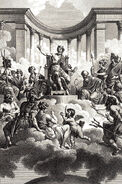| This article is about the Isu. You may be looking for the ancient Greek blacksmith. |
- "When I was flesh, I apprenticed with Hephaestus, the maker. The War of Unification raged. We created devastating Swords to end it, but then... killed. I created Shrouds, to heal."
- ―Consus, mentioning his master, Hephaestus[src]
Hephaistos, alternatively Hephaestus, was an Isu metal forger and weaponsmith who lived during the War of Unification. He was also the teacher of Consus, another Isu.
Biography
During the Isu Era, Hephaistos was known as 'the maker' among his people, having created many Pieces of Eden, and at one point trained Consus, who later used his teachings to construct his own Pieces of Eden, such as the Shrouds, which helped counteract the use of the artifacts as weapons and introduce a method to heal injured Isu during the Human-Isu War.[1] During his time in Atlantis, Hephaistos also created a forge beneath Poseidon's palace and created numerous weapon blueprints which could be used with the forge.[2]
Hephaistos was also responsible for the creation of what would later be known as the Spear of Leonidas - it could be improved at the Isu site known as the Ancient Forge on the island of Andros. The Forge held the apparent mould for the spear, as well as the moulds for a sword, an axe and a halberd. Hephaistos also created a hammer held by the Cyclops Arges. [3]

A 5th century BCE mural of Hephaistos, holding tongs and riding a donkey
Mythology
In Greek mythology, Hephaistos was said to have a limp. When this was discovered by the goddess Hera, who was said to have been his mother, she threw him off Mount Olympos. He landed in the sea near Lemnos, where sea deities rescued him.[4]
Hephaistos also helped the hero Herakles with at least one of his tasks, though indirectly. Hephaistos was the creator of the rattle which the goddess Athena gave to Herakles to scare the Stymphalian birds out of hiding.[5]
Influence and legacy
Hephaistos' memory survived among humans as a revered god of smithing and fire, forgework and volcanoes, especially in Greco-Roman mythologies. In them, he was also called The Lame One, for he was believed to have a weak leg, either as a birth defect, or as a consequence of an accident.[6]
Many of his creations survived the end of the Isu's reign, becoming objects of divine origin among humanity.
During the 5th century BCE, the islands of Thasos and Lemnos were known as the Hephaistos Islands, with the latter housing a notable temple dedicated to Hephaistos. The volcanic island north of Argolis was called the Foundry of Hephaistos.[3]
In addition, the polis Athens housed a temple dedicated to him.[3]
Some claimed that a cave hiding curious architecture in its depths in the northern parts of Malis held Hephaistos' workshop.[3]
In 2012, Desmond Miles' team used the Hephaestus Email Network, named after the god, for communication.[7][8]
Behind the scenes
The mural depicting Hephaistos riding a donkey in Assassin's Creed: Odyssey is based on a vase painting from the 5th century BCE.
Gallery
Appearances
- Assassin's Creed: Syndicate (mentioned in Database entry only)
- Assassin's Creed: Odyssey (statue only)
- The Fate of Atlantis: Fields of Elysium (mentioned only)
- The Fate of Atlantis: Judgment of Atlantis (voice only)
References
- ↑ Assassin's Creed: Syndicate – Database: Reconstructed Data 003
- ↑ Assassin's Creed: Odyssey – The Fate of Atlantis: Judgment of Atlantis
- ↑ 3.0 3.1 3.2 3.3 Assassin's Creed: Odyssey
- ↑ Assassin's Creed: Odyssey – Lemnos: Temple of Hephaistos
- ↑ Assassin's Creed: Odyssey – Arkadia: The Stymphalian Birds
- ↑ Assassin's Creed: Odyssey – Lover's letter to Hermippos
- ↑ Assassin's Creed: Brotherhood
- ↑ Assassin's Creed III


